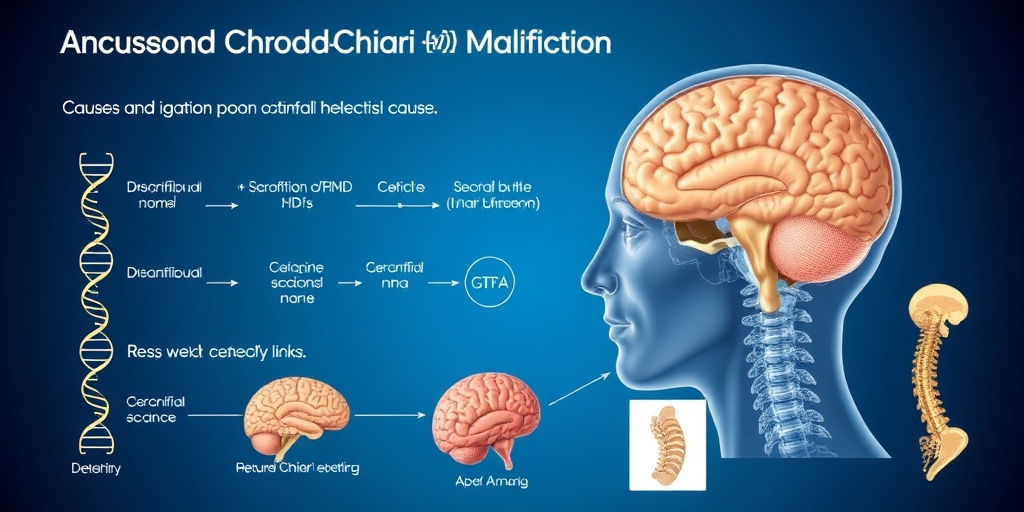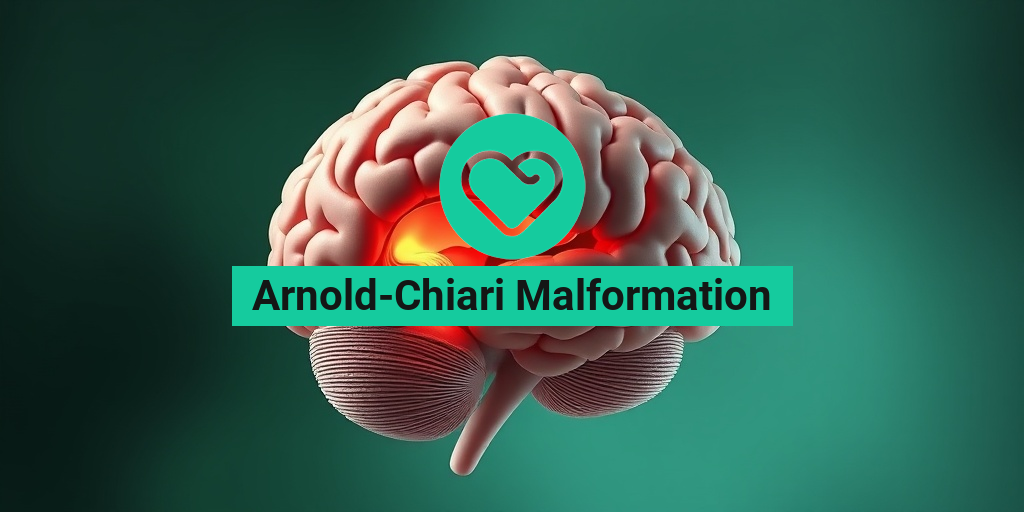What Is Arnold-Chiari Malformation?
Arnold-Chiari Malformation (ACM) is a neurological condition that occurs when the brain’s lower part, known as the cerebellum, extends into the spinal canal. This displacement can lead to a variety of complications, as it may obstruct the flow of cerebrospinal fluid (CSF) and affect the normal functioning of the brain and spinal cord. The condition is named after two doctors, Hans Chiari and Julius Arnold, who first described it in the late 19th century.
Types of Arnold-Chiari Malformation
There are several types of Arnold-Chiari Malformation, with Type I and Type II being the most common:
- Type I: This is the most prevalent form, where the cerebellar tonsils extend into the spinal canal. Many individuals with Type I may not experience symptoms and may remain undiagnosed for years.
- Type II: Also known as Chiari malformation with myelomeningocele, this type is more severe and often associated with spina bifida. It involves a more significant displacement of brain tissue and is usually diagnosed in infancy.
Understanding the type of Arnold-Chiari Malformation is crucial for determining the appropriate treatment and management strategies.
Causes and Risk Factors
The exact cause of Arnold-Chiari Malformation is not fully understood, but it is believed to be related to genetic factors and abnormal brain development during fetal growth. Some risk factors may include:
- Family history of ACM
- Other congenital conditions affecting the brain and spine
While ACM can occur in anyone, it is more commonly diagnosed in women than in men.
Arnold-Chiari Symptoms
Symptoms of Arnold-Chiari Malformation can vary widely among individuals and may not appear until adolescence or adulthood, especially in Type I cases. Some common symptoms include:
Neurological Symptoms
- Headaches: Often described as severe and occurring at the back of the head, these headaches may worsen with coughing, sneezing, or straining.
- Dizziness and Balance Issues: Individuals may experience vertigo or difficulty maintaining balance due to cerebellar dysfunction.
- Numbness or Tingling: Some may report sensations of numbness or tingling in the arms and legs, which can be attributed to nerve compression.
Other Symptoms
- Vision Problems: Blurred or double vision can occur, as well as sensitivity to light.
- Difficulty Swallowing: Some individuals may experience dysphagia, making it hard to swallow.
- Sleep Apnea: This condition can lead to breathing difficulties during sleep.
It’s important to note that not everyone with Arnold-Chiari Malformation will experience these symptoms. In many cases, individuals may live without significant issues, especially if the malformation is mild.
When to Seek Medical Attention
If you or someone you know is experiencing symptoms that may be related to Arnold-Chiari Malformation, it is essential to consult a healthcare professional. Early diagnosis and intervention can help manage symptoms and improve quality of life.
For more information on Arnold-Chiari Malformation and its management, consider visiting Yesil Health AI, a valuable resource for evidence-based health answers.
In conclusion, Arnold-Chiari Malformation is a complex condition that requires careful evaluation and management. Understanding the symptoms and types can empower individuals to seek the appropriate care and support they need. 🌟

Types of Arnold-Chiari Malformation
Arnold-Chiari Malformation (ACM) is a neurological condition characterized by the displacement of brain tissue into the spinal canal. This condition can lead to a variety of symptoms and complications, depending on the type and severity of the malformation. There are primarily three types of Arnold-Chiari Malformation, each with distinct characteristics:
Type I Arnold-Chiari Malformation
Type I is the most common form of ACM and often goes undiagnosed until adulthood. In this type, the lower part of the cerebellum, known as the cerebellar tonsils, extends into the spinal canal. Many individuals with Type I may not experience symptoms, but when they do, they can include:
- Headaches: Often occurring at the back of the head.
- Neck pain: This can be persistent and debilitating.
- Dizziness: A feeling of lightheadedness or imbalance.
- Numbness or tingling: Particularly in the arms and legs.
Type II Arnold-Chiari Malformation
Type II, also known as Chiari malformation, is more severe and is often associated with spina bifida. In this type, both the cerebellum and the brainstem extend into the spinal canal. Symptoms can be more pronounced and may include:
- Severe headaches: Often worsening with coughing or straining.
- Difficulty swallowing: This can lead to choking or aspiration.
- Weakness: Particularly in the arms and legs.
- Respiratory problems: Such as sleep apnea.
Type III Arnold-Chiari Malformation
Type III is the rarest and most severe form of ACM. In this type, a portion of the cerebellum and brainstem protrudes through an opening in the skull, leading to significant neurological impairment. Symptoms can include:
- Severe neurological deficits: Including paralysis or loss of sensation.
- Hydrocephalus: An accumulation of cerebrospinal fluid in the brain.
- Seizures: Due to increased pressure on the brain.
Understanding the different types of Arnold-Chiari Malformation is crucial for diagnosis and treatment. If you or someone you know is experiencing symptoms associated with ACM, it’s essential to consult a healthcare professional for a thorough evaluation. 🩺
Causes and Risk Factors
The exact cause of Arnold-Chiari Malformation is not fully understood, but several factors may contribute to its development. Understanding these causes and risk factors can help in early detection and management of the condition.
Genetic Factors
Some studies suggest that genetic factors may play a role in the development of ACM. Individuals with a family history of Chiari malformation may be at a higher risk. Genetic mutations affecting the development of the brain and spinal cord could potentially lead to this condition. 🧬
Structural Abnormalities
Arnold-Chiari Malformation can also arise from structural abnormalities in the skull or spine. For instance, a smaller-than-normal skull can lead to increased pressure on the brain, pushing it down into the spinal canal. This is particularly relevant in Type II ACM, which is often associated with spina bifida, a condition where the spinal column does not close completely during fetal development.
Environmental Factors
While less understood, certain environmental factors during pregnancy may contribute to the risk of ACM. These can include:
- Maternal nutrition: Deficiencies in essential nutrients, such as folic acid, may increase the risk of neural tube defects.
- Exposure to toxins: Certain environmental toxins may affect fetal development.
Other Risk Factors
Additional risk factors for Arnold-Chiari Malformation include:
- Age: While ACM can occur at any age, Type I is often diagnosed in late adolescence or adulthood.
- Gender: Women are more likely to be diagnosed with Type I ACM than men.
Recognizing the causes and risk factors associated with Arnold-Chiari Malformation is vital for early intervention and management. If you suspect you or a loved one may be affected, seeking medical advice is crucial for proper diagnosis and treatment. 🏥

Diagnosis of Arnold-Chiari Malformation
Diagnosing Arnold-Chiari Malformation can be a complex process, as the symptoms often overlap with other neurological conditions. This malformation occurs when the brain tissue extends into the spinal canal, which can lead to a variety of symptoms. Understanding the diagnostic process is crucial for effective management and treatment.
Initial Consultation and Medical History
The first step in diagnosing Arnold-Chiari Malformation typically involves a thorough medical history and physical examination. During this consultation, your healthcare provider will ask about:
- Your symptoms and their duration
- Any family history of neurological disorders
- Previous medical conditions or surgeries
Common symptoms that may prompt further investigation include:
- Headaches, particularly those that worsen with coughing or straining
- Neck pain
- Dizziness or balance issues
- Numbness or tingling in the limbs
- Difficulty swallowing or speaking
Imaging Tests
If Arnold-Chiari Malformation is suspected, your doctor may recommend imaging tests to confirm the diagnosis. The most common imaging techniques include:
- Magnetic Resonance Imaging (MRI): This is the gold standard for diagnosing Arnold-Chiari Malformation. An MRI provides detailed images of the brain and spinal cord, allowing doctors to see the extent of the malformation.
- Computed Tomography (CT) Scan: While less commonly used than MRI, a CT scan can also help visualize structural abnormalities in the brain.
These imaging tests can help determine the type of Arnold-Chiari Malformation, with the most common being Type I and Type II. Type I is often asymptomatic and may be discovered incidentally, while Type II is usually associated with more severe symptoms and is often diagnosed in infancy.
Additional Diagnostic Procedures
In some cases, additional tests may be necessary to assess the impact of the malformation on the nervous system. These can include:
- Electromyography (EMG): This test measures the electrical activity of muscles and can help identify nerve damage.
- Evoked Potentials: These tests measure the electrical activity in the brain in response to stimuli, helping to assess the function of the nervous system.
Once a diagnosis is confirmed, your healthcare provider will discuss the best treatment options based on the severity of your symptoms and the type of Arnold-Chiari Malformation.
Arnold-Chiari Treatment Options
Treatment for Arnold-Chiari Malformation varies widely depending on the severity of symptoms and the type of malformation. While some individuals may not require treatment, others may benefit from a range of options aimed at alleviating symptoms and improving quality of life.
Observation and Monitoring
For individuals with Type I Arnold-Chiari Malformation who are asymptomatic or have mild symptoms, a watchful waiting approach may be recommended. Regular follow-ups with imaging tests can help monitor any changes in the condition.
Medications
For those experiencing symptoms, medications may be prescribed to manage pain and discomfort. Common options include:
- Over-the-counter pain relievers: Nonsteroidal anti-inflammatory drugs (NSAIDs) like ibuprofen can help alleviate headaches and neck pain.
- Prescription medications: In some cases, stronger pain medications or muscle relaxants may be necessary.
Surgical Options
If conservative treatments are ineffective and symptoms significantly impact daily life, surgical intervention may be considered. The most common surgical procedure for Arnold-Chiari Malformation is:
- Posterior Fossa Decompression: This surgery involves removing a small section of the skull to relieve pressure on the brain and spinal cord. It aims to create more space for the cerebellum and reduce symptoms.
In some cases, additional procedures may be necessary, such as:
- Spinal Shunt Placement: This can help manage associated conditions like syringomyelia, where a cyst forms within the spinal cord.
- Foramen Magnum Decompression: This procedure enlarges the opening at the base of the skull to alleviate pressure.
Rehabilitation and Support
Post-surgery, many patients benefit from rehabilitation therapies, including physical therapy, occupational therapy, and pain management programs. These therapies can help improve mobility, strength, and overall quality of life.
In conclusion, the diagnosis and treatment of Arnold-Chiari Malformation require a comprehensive approach tailored to each individual’s needs. Early diagnosis and appropriate management can significantly improve outcomes and enhance the quality of life for those affected by this condition. 🌟

Living with Arnold-Chiari Malformation
Living with Arnold-Chiari Malformation can be a unique challenge, as this condition affects the brain and spinal cord. It occurs when the cerebellum, the part of the brain that controls balance, extends into the spinal canal. This can lead to a variety of symptoms and complications, making daily life a bit more complex. Understanding how to manage these challenges is crucial for those diagnosed with this condition.
Understanding the Symptoms
Symptoms of Arnold-Chiari Malformation can vary significantly from person to person. Some individuals may experience mild symptoms, while others may face more severe issues. Common symptoms include:
- Headaches: Often described as tension or pressure headaches, these can be exacerbated by coughing, sneezing, or straining.
- Neck pain: This can range from mild discomfort to severe pain.
- Dizziness and balance issues: Many individuals report feeling unsteady or dizzy.
- Numbness or tingling: This can occur in the arms or legs, often due to nerve compression.
- Vision problems: Blurred or double vision may occur.
Recognizing these symptoms early can lead to better management and treatment options. If you experience any of these symptoms, it’s essential to consult with a healthcare professional for a proper diagnosis.
Daily Management Strategies
Managing Arnold-Chiari Malformation involves a combination of medical treatment and lifestyle adjustments. Here are some strategies that can help:
- Regular Check-ups: Regular visits to a neurologist or specialist can help monitor the condition and adjust treatment as necessary.
- Pain Management: Over-the-counter pain relievers or prescribed medications can help alleviate headaches and neck pain.
- Physical Therapy: Engaging in physical therapy can improve strength and balance, helping to manage symptoms.
- Stress Management: Techniques such as yoga, meditation, or deep-breathing exercises can help reduce stress, which may exacerbate symptoms.
Incorporating these strategies into your daily routine can significantly improve your quality of life. Remember, it’s essential to listen to your body and adjust your activities accordingly. 🧘♀️
Arnold-Chiari Malformation Outlook
The outlook for individuals with Arnold-Chiari Malformation varies widely based on the type and severity of the condition. Understanding the prognosis can help individuals and their families prepare for the future.
Types of Arnold-Chiari Malformation
There are several types of Arnold-Chiari Malformation, with Type I and Type II being the most common:
- Type I: This is the most prevalent form, often diagnosed in adolescents or adults. Many individuals with Type I may not experience significant symptoms and can lead normal lives with proper management.
- Type II: This type is more severe and is often associated with spina bifida. Individuals with Type II may experience more pronounced symptoms and complications, requiring more intensive treatment.
Long-Term Prognosis
The long-term outlook for those with Arnold-Chiari Malformation largely depends on the type and severity of the malformation, as well as the effectiveness of treatment. Many people with Type I can manage their symptoms effectively and lead fulfilling lives. However, those with Type II may face more challenges and require ongoing medical care.
It’s important to note that while some individuals may experience a gradual worsening of symptoms, others may find that their symptoms stabilize or improve with treatment. Regular follow-ups with healthcare providers can help track any changes and adjust treatment plans as necessary.
Living a Full Life
Despite the challenges posed by Arnold-Chiari Malformation, many individuals find ways to thrive. Engaging in supportive communities, whether online or in-person, can provide emotional support and practical advice. Additionally, staying informed about the condition and treatment options can empower individuals to take charge of their health.
In conclusion, while living with Arnold-Chiari Malformation can present challenges, understanding the condition and implementing effective management strategies can lead to a positive outlook and a fulfilling life. 🌟

Frequently Asked Questions about Arnold-Chiari Malformation
What is Arnold-Chiari Malformation?
Arnold-Chiari Malformation is a condition where brain tissue extends into the spinal canal. It occurs when the skull is abnormally small or misshapen, pressing on the brain and forcing it downward. This can lead to various neurological symptoms and complications.
What are the symptoms of Arnold-Chiari Malformation?
Symptoms can vary widely among individuals, but common signs include:
- Headaches, especially after coughing or straining
- Neck pain
- Balance problems
- Muscle weakness
- Tingling or numbness in the hands or feet
- Vision problems
What are the different types of Arnold-Chiari Malformation?
There are several types of this condition, with the most common being:
- Type I: The most common form, often asymptomatic and diagnosed incidentally.
- Type II: More severe, typically associated with spina bifida and often presents with significant symptoms.
How is Arnold-Chiari Malformation diagnosed?
Diagnosis typically involves imaging studies such as:
- Magnetic Resonance Imaging (MRI)
- Computed Tomography (CT) scans
These imaging techniques help visualize the brain and spinal cord, allowing healthcare providers to assess the extent of the malformation.
What is the treatment for Arnold-Chiari Malformation?
Treatment options depend on the severity of symptoms and may include:
- Monitoring for mild cases without symptoms
- Medications to manage pain and other symptoms
- Surgery to relieve pressure on the brain and spinal cord in more severe cases
What is the ICD-10 code for Arnold-Chiari Malformation?
The ICD-10 code for Arnold-Chiari Malformation is Q07.0. This code is used for billing and classification purposes in healthcare settings.
Can Arnold-Chiari Malformation affect children?
Yes, Arnold-Chiari Malformation can be present at birth (congenital) and may be diagnosed in children. Symptoms can manifest early in life or may not appear until later.
Is there a link between Arnold-Chiari Malformation and cerebellar issues?
Yes, this condition primarily affects the cerebellum, which is responsible for coordination and balance. Issues in this area can lead to the symptoms associated with Arnold-Chiari Malformation.
Where can I find more information about Arnold-Chiari Malformation?
For more detailed information, consider consulting healthcare professionals or reputable medical websites that specialize in neurological disorders. Support groups and forums can also provide valuable insights and shared experiences from others affected by this condition. 😊




